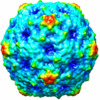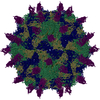[English] 日本語
 Yorodumi
Yorodumi- EMDB-5928: Kinetic and Structural Analysis of Coxsackievirus B3 Receptor Int... -
+ Open data
Open data
- Basic information
Basic information
| Entry | Database: EMDB / ID: EMD-5928 | |||||||||
|---|---|---|---|---|---|---|---|---|---|---|
| Title | Kinetic and Structural Analysis of Coxsackievirus B3 Receptor Interactions and Formation of the A-particle | |||||||||
 Map data Map data | Reconstruction of CVB3 A-particle transitioned by CAR | |||||||||
 Sample Sample |
| |||||||||
 Keywords Keywords | coxsackievirus b3 / cvb3 / CAR / cryoEM / A-particle | |||||||||
| Biological species |   Human coxsackievirus B3 Human coxsackievirus B3 | |||||||||
| Method | single particle reconstruction / cryo EM / Resolution: 9.0 Å | |||||||||
 Authors Authors | Organtini LJ / Makhov AM / Conway JF / Hafenstein S / Carson SD | |||||||||
 Citation Citation |  Journal: J Virol / Year: 2014 Journal: J Virol / Year: 2014Title: Kinetic and structural analysis of coxsackievirus B3 receptor interactions and formation of the A-particle. Authors: Lindsey J Organtini / Alexander M Makhov / James F Conway / Susan Hafenstein / Steven D Carson /  Abstract: The coxsackievirus and adenovirus receptor (CAR) has been identified as the cellular receptor for group B coxsackieviruses, including serotype 3 (CVB3). CAR mediates infection by binding to CVB3 and ...The coxsackievirus and adenovirus receptor (CAR) has been identified as the cellular receptor for group B coxsackieviruses, including serotype 3 (CVB3). CAR mediates infection by binding to CVB3 and catalyzing conformational changes in the virus that result in formation of the altered, noninfectious A-particle. Kinetic analyses show that the apparent first-order rate constant for the inactivation of CVB3 by soluble CAR (sCAR) at physiological temperatures varies nonlinearly with sCAR concentration. Cryo-electron microscopy (cryo-EM) reconstruction of the CVB3-CAR complex resulted in a 9.0-Å resolution map that was interpreted with the four available crystal structures of CAR, providing a consensus footprint for the receptor binding site. The analysis of the cryo-EM structure identifies important virus-receptor interactions that are conserved across picornavirus species. These conserved interactions map to variable antigenic sites or structurally conserved regions, suggesting a combination of evolutionary mechanisms for receptor site preservation. The CAR-catalyzed A-particle structure was solved to a 6.6-Å resolution and shows significant rearrangement of internal features and symmetric interactions with the RNA genome. IMPORTANCE: This report presents new information about receptor use by picornaviruses and highlights the importance of attaining at least an ∼9-Å resolution for the interpretation of cryo-EM ...IMPORTANCE: This report presents new information about receptor use by picornaviruses and highlights the importance of attaining at least an ∼9-Å resolution for the interpretation of cryo-EM complex maps. The analysis of receptor binding elucidates two complementary mechanisms for preservation of the low-affinity (initial) interaction of the receptor and defines the kinetics of receptor-catalyzed conformational change to the A-particle. | |||||||||
| History |
|
- Structure visualization
Structure visualization
| Movie |
 Movie viewer Movie viewer |
|---|---|
| Structure viewer | EM map:  SurfView SurfView Molmil Molmil Jmol/JSmol Jmol/JSmol |
| Supplemental images |
- Downloads & links
Downloads & links
-EMDB archive
| Map data |  emd_5928.map.gz emd_5928.map.gz | 65.4 MB |  EMDB map data format EMDB map data format | |
|---|---|---|---|---|
| Header (meta data) |  emd-5928-v30.xml emd-5928-v30.xml emd-5928.xml emd-5928.xml | 9.8 KB 9.8 KB | Display Display |  EMDB header EMDB header |
| Images |  400_5928.gif 400_5928.gif 80_5928.gif 80_5928.gif | 102.5 KB 6.8 KB | ||
| Archive directory |  http://ftp.pdbj.org/pub/emdb/structures/EMD-5928 http://ftp.pdbj.org/pub/emdb/structures/EMD-5928 ftp://ftp.pdbj.org/pub/emdb/structures/EMD-5928 ftp://ftp.pdbj.org/pub/emdb/structures/EMD-5928 | HTTPS FTP |
-Validation report
| Summary document |  emd_5928_validation.pdf.gz emd_5928_validation.pdf.gz | 78.4 KB | Display |  EMDB validaton report EMDB validaton report |
|---|---|---|---|---|
| Full document |  emd_5928_full_validation.pdf.gz emd_5928_full_validation.pdf.gz | 77.5 KB | Display | |
| Data in XML |  emd_5928_validation.xml.gz emd_5928_validation.xml.gz | 493 B | Display | |
| Arichive directory |  https://ftp.pdbj.org/pub/emdb/validation_reports/EMD-5928 https://ftp.pdbj.org/pub/emdb/validation_reports/EMD-5928 ftp://ftp.pdbj.org/pub/emdb/validation_reports/EMD-5928 ftp://ftp.pdbj.org/pub/emdb/validation_reports/EMD-5928 | HTTPS FTP |
-Related structure data
- Links
Links
| EMDB pages |  EMDB (EBI/PDBe) / EMDB (EBI/PDBe) /  EMDataResource EMDataResource |
|---|
- Map
Map
| File |  Download / File: emd_5928.map.gz / Format: CCP4 / Size: 161.1 MB / Type: IMAGE STORED AS FLOATING POINT NUMBER (4 BYTES) Download / File: emd_5928.map.gz / Format: CCP4 / Size: 161.1 MB / Type: IMAGE STORED AS FLOATING POINT NUMBER (4 BYTES) | ||||||||||||||||||||||||||||||||||||||||||||||||||||||||||||||||||||
|---|---|---|---|---|---|---|---|---|---|---|---|---|---|---|---|---|---|---|---|---|---|---|---|---|---|---|---|---|---|---|---|---|---|---|---|---|---|---|---|---|---|---|---|---|---|---|---|---|---|---|---|---|---|---|---|---|---|---|---|---|---|---|---|---|---|---|---|---|---|
| Annotation | Reconstruction of CVB3 A-particle transitioned by CAR | ||||||||||||||||||||||||||||||||||||||||||||||||||||||||||||||||||||
| Projections & slices | Image control
Images are generated by Spider. | ||||||||||||||||||||||||||||||||||||||||||||||||||||||||||||||||||||
| Voxel size | X=Y=Z: 1.25 Å | ||||||||||||||||||||||||||||||||||||||||||||||||||||||||||||||||||||
| Density |
| ||||||||||||||||||||||||||||||||||||||||||||||||||||||||||||||||||||
| Symmetry | Space group: 1 | ||||||||||||||||||||||||||||||||||||||||||||||||||||||||||||||||||||
| Details | EMDB XML:
CCP4 map header:
| ||||||||||||||||||||||||||||||||||||||||||||||||||||||||||||||||||||
-Supplemental data
- Sample components
Sample components
-Entire : Coxsackievirus B3 A-Particle
| Entire | Name: Coxsackievirus B3 A-Particle |
|---|---|
| Components |
|
-Supramolecule #1000: Coxsackievirus B3 A-Particle
| Supramolecule | Name: Coxsackievirus B3 A-Particle / type: sample / ID: 1000 / Details: purified virus and receptor complex in solution / Oligomeric state: icosahedral virus / Number unique components: 1 |
|---|---|
| Molecular weight | Experimental: 7 MDa |
-Supramolecule #1: Human coxsackievirus B3
| Supramolecule | Name: Human coxsackievirus B3 / type: virus / ID: 1 / Name.synonym: CVB3 Details: Virus was incubated with excess CAR at 4 degrees C then transitioned to 37 degrees C in order to create the A-particle. NCBI-ID: 12072 / Sci species name: Human coxsackievirus B3 / Sci species strain: CVB3/28 / Database: NCBI / Virus type: VIRION / Virus isolate: STRAIN / Virus enveloped: No / Virus empty: No / Syn species name: CVB3 |
|---|---|
| Host (natural) | Organism:  Homo sapiens (human) / synonym: VERTEBRATES Homo sapiens (human) / synonym: VERTEBRATES |
| Molecular weight | Experimental: 7 MDa |
| Virus shell | Shell ID: 1 / Name: VP1-4 / Diameter: 300 Å / T number (triangulation number): 1 |
-Experimental details
-Structure determination
| Method | cryo EM |
|---|---|
 Processing Processing | single particle reconstruction |
| Aggregation state | particle |
- Sample preparation
Sample preparation
| Concentration | 0.1 mg/mL |
|---|---|
| Buffer | pH: 6 / Details: 50 mM MES, 100 mM NaCl |
| Grid | Details: glow-discharged holey carbon Quantifoil electron microscopy grids |
| Vitrification | Cryogen name: ETHANE-PROPANE MIXTURE / Chamber humidity: 95 % / Chamber temperature: 95 K / Instrument: FEI VITROBOT MARK III |
- Electron microscopy
Electron microscopy
| Microscope | FEI TECNAI F20 |
|---|---|
| Alignment procedure | Legacy - Astigmatism: CTFFIND3 |
| Date | Aug 1, 2012 |
| Image recording | Category: FILM / Film or detector model: KODAK SO-163 FILM / Digitization - Scanner: NIKON SUPER COOLSCAN 9000 / Digitization - Sampling interval: 6.35 µm / Number real images: 48 / Average electron dose: 15 e/Å2 |
| Electron beam | Acceleration voltage: 200 kV / Electron source:  FIELD EMISSION GUN FIELD EMISSION GUN |
| Electron optics | Calibrated magnification: 50000 / Illumination mode: SPOT SCAN / Imaging mode: BRIGHT FIELD / Cs: 2 mm / Nominal defocus max: 5.2 µm / Nominal defocus min: 2.33 µm / Nominal magnification: 50000 |
| Sample stage | Specimen holder model: GATAN LIQUID NITROGEN |
| Experimental equipment |  Model: Tecnai F20 / Image courtesy: FEI Company |
- Image processing
Image processing
| Details | Particles were selected using EMAN. |
|---|---|
| CTF correction | Details: AUTO3DEM |
| Final reconstruction | Algorithm: OTHER / Resolution.type: BY AUTHOR / Resolution: 9.0 Å / Resolution method: OTHER / Software - Name: EMAN, AUTO3DEM / Number images used: 41939 |
 Movie
Movie Controller
Controller














 Z (Sec.)
Z (Sec.) Y (Row.)
Y (Row.) X (Col.)
X (Col.)





















